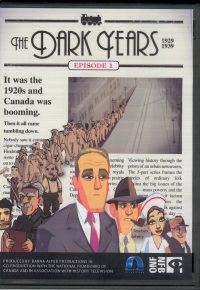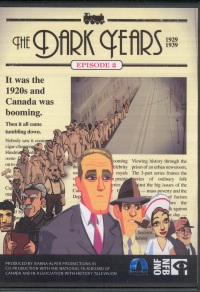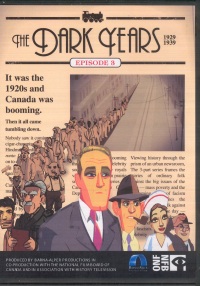| ________________
CM . . .
. Volume XV Number 22. . . .June 26, 2009 
 |
The Dark Years 1929-1939: Episode 1.
Steven Silver (Director). Laszlo Barna (Producer Chuck Gammage Animation Inc). Gerry Flahive (NFB Producer). Laszlo Barna & Steven Silver (Executive Producers). Silva Basmajian (NFB Executive Producer).
Montreal, PQ: National Film Board of Canada, 2008.
46 min., 58 sec., DVD, $99.95.
Order Number: 153C 9107 399.
Grades 10 and up / Ages 15 and up.
Review by Joanne Peters.
**** /4
|
| |
|
 |
The Dark Years 1929-1939: Episode 2.
Steven Silver (Director). Laszlo Barna (Producer Chuck Gammage Animation Inc). Gerry Flahive (NFB Producer). Laszlo Barna & Steven Silver (Executive Producers). Silva Basmajian (NFB Executive Producer).
Montreal, PQ: National Film Board of Canada, 2008.
46 min., 53 sec., DVD, $99.95.
Order Number: 153C 9107 398.
Grades 10 and up / Ages 15 and up.
Review by Joanne Peters.
**** /4 |
| |
|
 |
The Dark Years 1929-1939: Episode 3.
Steven Silver (Director). Laszlo Barna (Producer Chuck Gammage Animation Inc). Gerry Flahive (NFB Producer). Laszlo Barna & Steven Silver (Executive Producers). Silva Basmajian (NFB Executive Producer).
Montreal, PQ: National Film Board of Canada, 2008.
46 min., 20 sec., DVD, $99.95.
Order Number: 153C 9107 397.
Grades 10 and up / Ages 15 and up.
Review by Joanne Peters.
**** /4
|
| |
|

Current newspapers and magazines feature stories about how to cope with the economic recession: people are discovering the rewards of cooking at home, are thinking twice about purchasing non-essentials (those who still have substantial disposable income assuage their guilt by having their purchases from trendy, big-ticket retailers bagged in plain "nameless" sacks), and are electing the "stay-cation" as the holiday of choice for the upcoming summer months. If my parents were still alive, they'd be laughing themselves silly at all of this: as children and teens growing up during "the dark years" of the Great Depression, they'd dismiss the problems of the current economic climate as a mere inconvenience.
As one woman states at the beginning of Episode 1of The Dark Years, 1929-1939, "we made up stories about being rich... beautiful clothes, the best food..." and these fantasies sustained many during that tough decade. An animated version of Harry Hindmarsh, Managing Editor for what was then Canada's largest newspaper, The Toronto Star, narrates the three-DVD series which tells the lived stories of real people who survived that decade. A mix of Looney Tunes-style animation, black and white newsreel footage, and personal interviews with a number of Canadians who lived through the Dark Years meld well in telling those stories. The optimism of the Roaring Twenties was followed by the Crash of Wall Street, and then, a crash in consumer confidence, massive job losses, and the financial ruin of those who had invested heavily in the market, and had lost much, or all of the personal fortunes. According to Hindmarsh, The Toronto Star's journalistic mandate was to "get there fast, get there first, miss nothing." Entertainment and human interest stories were its main focus, but it didn't shy away from social and political commentary. Gordon Sinclair (later known as a panelist on CBC's Front Page Challenge) was a young reporter for the Star, and, on assignment in Germany, he met Adolf Hitler, at first portrayed as an animated Mickey Mouse-like character, who, in the course of his rant at Sinclair, turns into a screaming red-hot devil. Another young reporter recounts his visit to the hobo jungle in the Don Valley area of Toronto, and the despair of the men living there is overwhelming. Finally, the political agitation of Tim Buck, the leader of Canada's Communist Party is also covered by the Star. Sentenced to time in Kingston Prison, notorious for its abysmal and inhuman conditions, Buck attracts new adherents and ultimately, faces an assassination attempt. The Star covers it all.
Perhaps because of its unpretentious "appeal to the little guy, "The Star's subscriptions rose during the worst years of the Depression. In Episode 2, which highlights the years from 1932-1934, the paper carries stories of pay cuts, hunger marches, the privations of the 1.3 million Canadians who are now on relief; it also carried truly heart-rending stories, such as the tale of Ted and Rose Bates, who lose their livelihood, and ultimately their son, when their attempt to poison themselves with carbon monoxide fails to end their lives but takes their son, their beloved "Nipper." However, the birth of the Dionne Quintuplets in Corbeil, ON, captivates the hearts of Canadians, and stories about the five tiny babies are a pleasant distraction from the terrible realities of work camps and civic riots in which jobless young men, riding the rails, become increasingly more angry and militant.
By 1935, the date in which Episode 3 opens, Prime Minister R. B. Bennett has left Ottawa (and ultimately, Canada), a political failure. William Lyon Mackenzie King is voted into power, and slowly, a series of economic reforms are brought into being: a guaranteed minimum wage, unemployment insurance, social safety nets which are now taken for granted. Agriculture continues to face hard times; The Star tells the story of a Saskatchewan farmer who looks out one day onto a field of wheat which will yield 60 bushels per acre and falls asleep that night dreaming of all that he can buy with the proceeds of his beautiful crop. That night, a plague of grasshoppers destroys it; the next scene is of an empty barn in which a gunshot rings out. The Dionnes continued to be Canada's darlings; they were big business, and feature stories guaranteed that copies of The Star would sell, The Star helped to change the nature of mass media. The Moose River Gold Mine disaster, in which three men were trapped below the surface was one of the first occasions in which radio was used, not for entertainment, but for live coverage of the progress of the rescue attempts.
The Star continued to cover left of centre politics. The paper followed the stories of unemployed young Canadian men who volunteered to fight Franco and fascism in Spain, and in 1938, the newspaper sent Matthew Halton (later of CBC journalistic fame) to Munich, to cover the meeting of Daladier, Mussolini, and Chamberlain with Hitler. Mr. Atkinson, The Star's owner, was a pacifist, but even he could see that another war in Europe was inevitable. And so, The Toronto Star turned its focus to the war in which Canada became a part in September of 1939. The Dark Years of the Depression were over as industry re-tooled to produce the weapons of war.
The Dark Years 1929-1939 does an excellent job of portraying significant historical events in Canada and internationally while offering a real sense of everyday human tragedies faced by "the little guy [and gal]" during an era of lost hopes and shattered dreams. An excellent resource for Senior High Social Studies teachers, it could also be used as background material for the teaching of novels set in the Depression years. Teachers should preview the series in order to determine whether to use all or part of any given episode. Constraints of time may lead a person to focusing on historical issues, instead of the social. However, whether viewed individually or as an entire series, The Dark Years 1929-1939 provides an accessible and enjoyable overview of Canadian political and social life during that era.
Highly Recommended.
Joanne Peters is a teacher-librarian at Kelvin High School in Winnipeg, MB.

To comment
on this title or this review, send mail to cm@umanitoba.ca.
Copyright © the Manitoba Library Association. Reproduction for personal
use is permitted only if this copyright notice is maintained. Any
other reproduction is prohibited without permission.
NEXT REVIEW |
TABLE OF CONTENTS FOR THIS ISSUE
- June 26, 2009.
AUTHORS |
TITLES |
MEDIA REVIEWS |
PROFILES |
BACK ISSUES |
SEARCH |
CMARCHIVE |
HOME |


